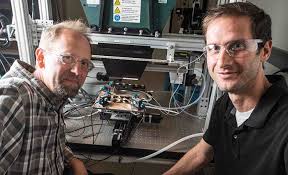
Breaking News
 Prepare For Coming World War, NATO Chief Says
Prepare For Coming World War, NATO Chief Says
 Israel Used Palantir Technology In Its 2024 Lebanon Pager Attack
Israel Used Palantir Technology In Its 2024 Lebanon Pager Attack
 Jordan Peterson Out Of Hospital But Still "Very Unwell", Daughter Says
Jordan Peterson Out Of Hospital But Still "Very Unwell", Daughter Says
 FDA Investigating Deaths Potentially Linked To COVID-19 Vaccines Across Age Ranges
FDA Investigating Deaths Potentially Linked To COVID-19 Vaccines Across Age Ranges
Top Tech News
 Build a Greenhouse HEATER that Lasts 10-15 DAYS!
Build a Greenhouse HEATER that Lasts 10-15 DAYS!
 Look at the genius idea he came up with using this tank that nobody wanted
Look at the genius idea he came up with using this tank that nobody wanted
 Latest Comet 3I Atlas Anomolies Like the Impossible 600,000 Mile Long Sunward Tail
Latest Comet 3I Atlas Anomolies Like the Impossible 600,000 Mile Long Sunward Tail
 Tesla Just Opened Its Biggest Supercharger Station Ever--And It's Powered By Solar And Batteries
Tesla Just Opened Its Biggest Supercharger Station Ever--And It's Powered By Solar And Batteries
 Your body already knows how to regrow limbs. We just haven't figured out how to turn it on yet.
Your body already knows how to regrow limbs. We just haven't figured out how to turn it on yet.
 We've wiretapped the gut-brain hotline to decode signals driving disease
We've wiretapped the gut-brain hotline to decode signals driving disease
 3D-printable concrete alternative hardens in three days, not four weeks
3D-printable concrete alternative hardens in three days, not four weeks
 Could satellite-beaming planes and airships make SpaceX's Starlink obsolete?
Could satellite-beaming planes and airships make SpaceX's Starlink obsolete?
Newly-Developed Solar Cell Earns Two World Records for Its 'Extraordinary' Efficiency

Scientists at the National Renewable Energy Laboratory (NREL) have fabricated a solar cell with an efficiency of nearly 50%.
For perspective, the average solar cell has an efficiency rate of 15% to 20%, meaning it's capable of converting just a small fraction of absorbed sunlight into electricity.
The newly-developed six-junction solar cell, however, now holds the world record for the highest solar conversion efficiency at 47.1%, which was measured under concentrated illumination. A variation of the same cell also set the efficiency record under one-sun illumination at 39.2%.
"This device really demonstrates the extraordinary potential of multijunction solar cells," said John Geisz, a principal scientist in the High-Efficiency Crystalline Photovoltaics Group at NREL and lead author of a new paper on the record-setting cell.
The paper appeared in the journal Nature Energy this week.
To construct the device, NREL researchers relied on III-V materials—so called because of their position on the periodic table—that have a wide range of light absorption properties. Each of the cell's six junctions (the photoactive layers) is specially designed to capture light from a specific part of the solar spectrum.
The device contains about 140 total layers of various III-V materials to support the performance of these junctions, and yet is three times narrower than a human hair. Due to their highly efficient nature and the cost associated with making them, III-V solar cells are most often used to power satellites, which prize III-V's unmatched performance.
On Earth, however, the six-junction solar cell is well-suited for use in concentrator photovoltaics, said Ryan France, co-author and a scientist in the III-V Multijunctions Group at NREL.

 First totally synthetic human brain model has been realized
First totally synthetic human brain model has been realized Mach-23 potato gun to shoot satellites into space
Mach-23 potato gun to shoot satellites into space

